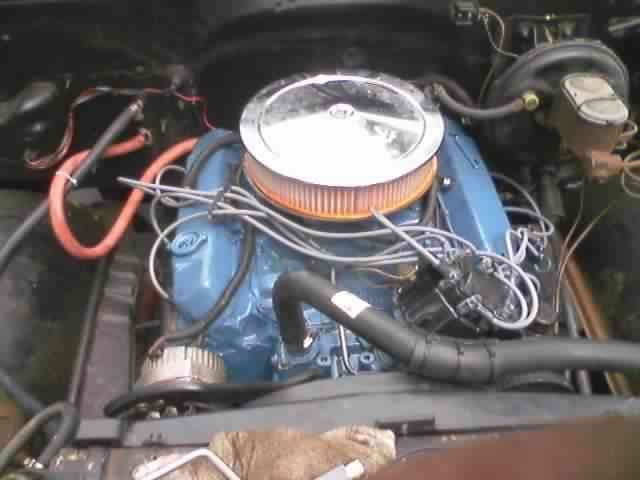Navigation
Install the app
How to install the app on iOS
Follow along with the video below to see how to install our site as a web app on your home screen.

Note: This feature currently requires accessing the site using the built-in Safari browser.
More options
You are using an out of date browser. It may not display this or other websites correctly.
You should upgrade or use an alternative browser.
You should upgrade or use an alternative browser.
What does engine blowby mean?
- Thread starter bigduby
- Start date
jrirvine1
Member
Means oil is blowing by around the pistons and rings, typically associated and is a symptom of bad compression. Blue smoke at start up is usually seen when the oil gets into the combustion chamber.
sprink56
New Member
- Oct 28, 2008
- 1,288
- Boat Info
- 1979 255 Liberator
- Engines
- twin Mercruiser 450 HP I/O on Bravo I Drives
Means the piston rings are nearing the end of their life span....they are not sealing the gap between the piston and the cylinder wall as they should.
jitts3
Well-Known Member
NO. Blowby is the compression and combustion blowing past the piston rings presureizing the crank case. This is why we have blowby tubes on trucks. At idle small amount of smoke/oil vapor comes out. I guess on boats its caught and recycled somewhere. Otherwise your engine room would fill up with the stuff? On a gas engine it it pulled in to the intake thru the PCV valve and re-burned. Not possible in a diesel due to being turbocharged. The intake is under pressure, not vacume.Means oil is blowing by around the pistons and rings, typically associated and is a symptom of bad compression. Blue smoke at start up is usually seen when the oil gets into the combustion chamber.
This does cause an engine to consume oil too. So he's right there.
Now here is where I don't know if I'd worry. I never measured blowby before. It is measured by 1.5 x engine Hp. So is a 200 diference alot? Compared to? Can't help there. Sorry.
EDIT: ALL engines have blowby. The older they are the more they have.
sprink56
New Member
- Oct 28, 2008
- 1,288
- Boat Info
- 1979 255 Liberator
- Engines
- twin Mercruiser 450 HP I/O on Bravo I Drives
NO. Blowby is the compression and combustion blowing past the piston rings presureizing the crank case. This is why we have blowby tubes on trucks. At idle small amount of smoke/oil vapor comes out. I guess on boats its caught and recycled somewhere. Otherwise your engine room would fill up with the stuff? On a gas engine it it pulled in to the intake thru the PCV valve and re-burned. Not possible in a diesel due to being turbocharged. The intake is under pressure, not vacume.
This does cause an engine to consume oil too. So he's right there.
Now here is where I don't know if I'd worry. I never measured blowby before. It is measured by 1.5 x engine Hp. So is a 200 diference alot? Compared to? Can't help there. Sorry.
EDIT: ALL engines have blowby. The older they are the more they have.
You are correct. What threw me off was the signature that listed 350 Chevy's:thumbsup:
jitts3
Well-Known Member
But still, the unit of measuer they are using to me means nothing. To me bad blowby is when the damn thing disapears in smoke out the oil fil and dipstick tube. Had this engne blow oil out the dipstick tube before rebuilding it. 425 CID Cadillac


So the biggest question is what does that 400+ number really mean? Its hard to know what is normal and what is a warning sign when you don't have anything to compare it too or any knowledge of the "norm". Also, if it is signs of wear, is it something that can be fixed when it gets too bad? This is on a cat 3116 350HP engine.
Thanks again.
Thanks again.
- Nov 12, 2006
- 5,334
- Boat Info
- 1999 Sea Ray 330DA
Twin 7.4 MPI (310 propshaft HP) V-drives
- Engines
- Twin Mercury Marine marinized 7.4L L-29 V8s
Cast iron block w 4-bolt mains
You have to ask Caterpillar. They built the engine, designed the test, and know how to interpret them. That should be part of the survey.
osd9
New Member
....... I guess on boats its caught and recycled somewhere. Otherwise your engine room would fill up with the stuff? On a gas engine it it pulled in to the intake thru the PCV valve and re-burned. Not possible in a diesel due to being turbocharged. The intake is under pressure, not vacume.
........
The WalkerAirseps handle the blowby gases....You can read how they work here....hit the Play button...
Last edited:
Thanks everyone for the info. I did finally get to talk to the Cat tech manager and get some answers. I appreciate the explanations, I am trying to learn this diesel stuff on the fly.. and eventually do my own maintenance if all works out with the sale of this boat.
Thanks again...
Thanks again...
jitts3
Well-Known Member
So the biggest question is what does that 400+ number really mean? Its hard to know what is normal and what is a warning sign when you don't have anything to compare it too or any knowledge of the "norm". Also, if it is signs of wear, is it something that can be fixed when it gets too bad? This is on a cat 3116 350HP engine.
Thanks again.
New "holes" This is cylender sleaves, piston, piston rings, connecting rod, and bearings.
It would come as a kit pre-assembled. Basiclly rebuilding the engine.

Thanks. Was wondering.The WalkerAirseps handle the blowby gases....You can read how they work here....hit the Play button...


